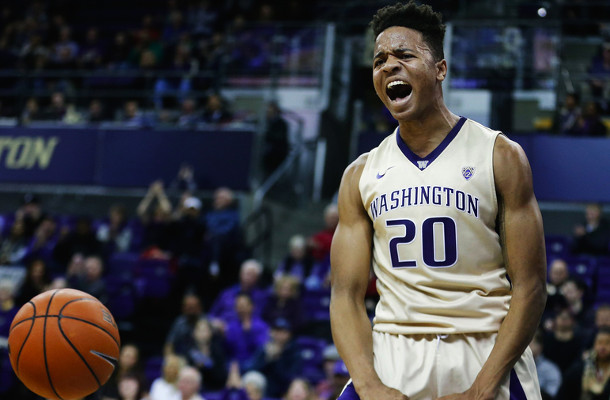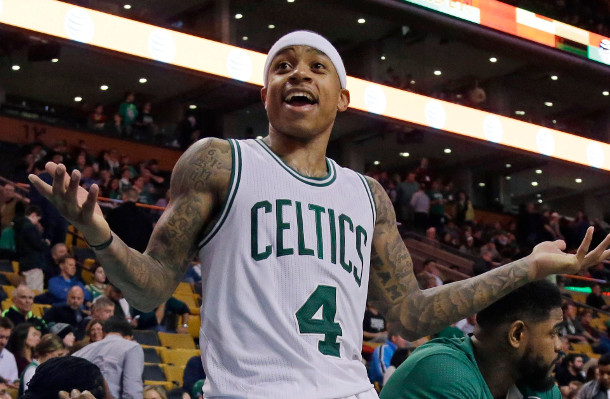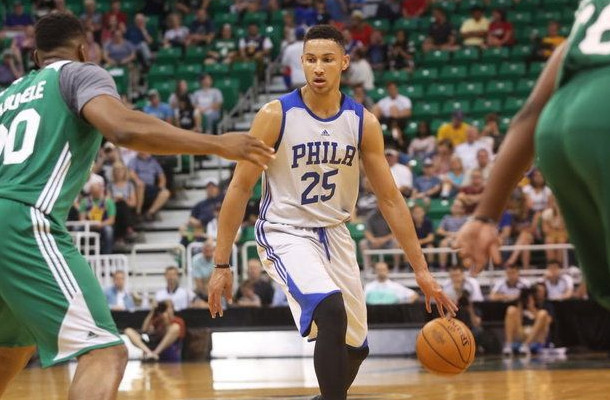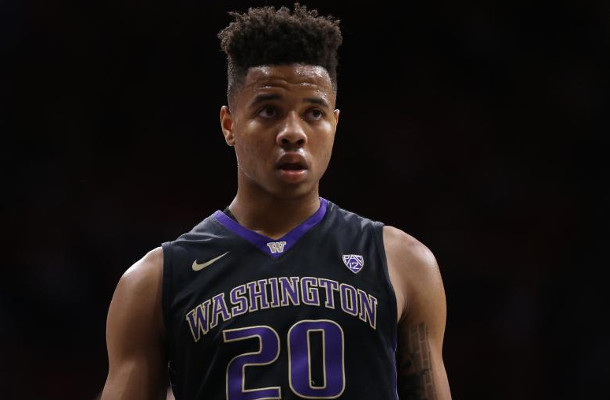Andrew Wiggins to win Rookie of the Year. Should Nerlens Noel have won?
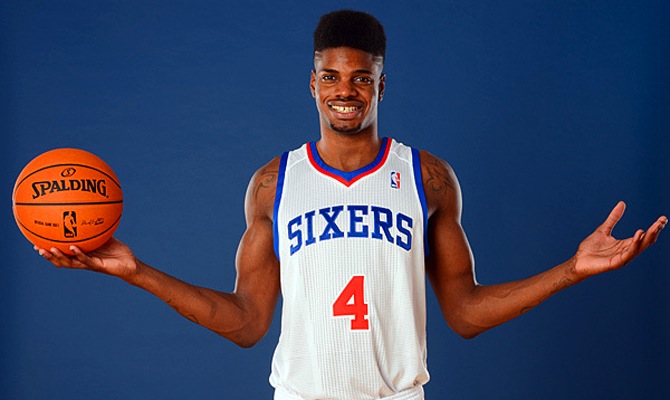
Later today, the Minnesota Timberwolves will hold a press conference, which Marc Spears of Yahoo Sports reports will be to announce Andrew Wiggins as the winner of the Rookie of the Year award.
The NBA has not yet announced the overall results of the voting, so we do not yet know where Nerlens Noel finished, or how close Noel was to Wiggins in the voting. Those results should be released later today.
The answer shouldn’t be a surprise to most fans. No Rookie of the Year winner has ever averaged less than 10 points per game and, since 1990, only 3 have averaged less than 15 points per night (Jason Kidd in 1994-95, Mike Miller in 2000-01, Amar’e Stoudemire in 2002-03). Noel, at 9.9 points per game on poor efficiency, never stood a real chance.
We like to talk about how the media is growing in its appreciation for defense and becoming more accepting of advanced statistics, but overwhelming precedent is hard to overcome. Until history is broken, I’m going to assume that historical precedent is maintained.
The question, then, becomes a simple one: was Nerlens Noel the best rookie this season.
The statistical outlook
Before we dive into some of the advanced statistics, let’s take a look their per-game, per-36 minutes, and per-100 possession averages.
| Player | Pts/g | Reb/g | Ast/g | St/g | Bl/g | FG% | 3pt% | FT% | Mins/g |
|---|---|---|---|---|---|---|---|---|---|
| Per Game | |||||||||
| Andrew Wiggins | 16.9 | 4.6 | 2.1 | 1.0 | 0.6 | 43.7% | 31.0% | 76.0% | 36.2 |
| Nerlens Noel | 9.9 | 8.1 | 1.7 | 1.8 | 1.9 | 46.2% | 0% | 60.9% | 30.8 |
| Per 36 minutes | |||||||||
| Andrew Wiggins | 16.8 | 4.5 | 2.1 | 1.0 | 0.6 | 43.7% | 31.0% | 76.0% | -- |
| Nerlens Noel | 11.6 | 9.5 | 2.0 | 2.1 | 2.2 | 46.2% | 0% | 60.9% | -- |
| Per 100 Possessions | |||||||||
| Andrew Wiggins | 23.8 | 6.4 | 2.9 | 1.5 | 0.9 | 43.7% | 31.0% | 76.0% | -- |
| Nerlens Noel | 16.1 | 13.3 | 2.8 | 2.9 | 3.1 | 46.2% | 0% | 60.9% | -- |
The differences between the two prospects become quite clear, with Wiggins more your typical volume-scorer, and Noel’s case based around his impressive (and unique) defensive metrics.
When you start taking a look at the advanced metrics, the difference becomes even more stark.
(Note: if you’re confused by some of these abbreviations, basketball-reference’s glossary is a pretty good place to start).
First, some of the all-in-one metrics:
| Player | PER | Win Shares | WS/48 | BPM | VORP |
|---|---|---|---|---|---|
| Andrew Wiggins | 13.9 | 2.1 | 0.034 | -2.3 | -0.2 |
| Nerlens Noel | 15.0 | 4.0 | 0.083 | 0.8 | 1.6 |
Noel wins virtually across the board here, which isn’t all that surprising as these types of stats all have their various biases, which usually favor the guy with the smaller role, or at least the role he’s more ready to fulfill right now.
Still, the universal nature of Noel’s dominance is hard to ignore.
Splitting them up into offensive and defensive metrics…
Offensive metrics:
| Player | Off. WS | OBPM | TS% | FTr | Ast% |
|---|---|---|---|---|---|
| Andrew Wiggins | 2.1 | -0.5 | 51.7% | 41.0% | 9.8% |
| Nerlens Noel | -0.2 | -3.7 | 49.3% | 35.2% | 9.8% |
Not surprising that Wiggins wins virtually across the board here, as his role on the Timberwolves was much more focused on Wiggins’ ability to score.
Still, a couple of things jump out.
First, Noel having the same assist rate as Wiggins is interesting. It highlights Noel’s surprising passing ability, which was fairly unique for a player of his otherwise limited offensive skill set. In fact, in terms of defensive-minded big men (6’10” or taller, block percentage greater than 5%), Noel’s 9.8% assist rate was the 13th best passing season for such a rookie big man all time. If you account for his low usage rate, and filter that for players with a usage rate less than 20%, only 3 rookies had a higher assist rate than Noel.
The second thing that jumps out to me is Wiggins’ free throw rate. Considering how much of a question mark Wiggins’ handles were, how well that free throw rate would translate was a question mark, and his 41% free throw rate was pretty good for a rookie wing using as many possessions as Wiggins did. In fact, for rookies with at least a 22% usage rate in their rookie season, Wiggins’ 41% was the 7th highest free throw rate, ahead of rookie seasons from guys like John Wall (40.4%), Tyreke Evans (39.9%), Kobe Bryant (39.3%), Dwyane Wade (39.1%), and Russell Westbrook (39.1%). Wiggins really improved in this regard after the All-Star break, going from 4.4 free throw attempts per game before the break to 7.9 per game after the break. While we as Sixers fans were so focused on Noel’s incredible post-deadline play (and rightfully so), this was a big development in Wiggins’ maturation.
Noel’s offensive season, while still bad, was saved from being historically bad because of his improvement after the All-Star break (46.7% true shooting percentage before the All-Star break, 52.8% after). That 46.7% true shooting percentage would have been one of the 10 worst seasons, efficiency wise, for a rookie big man (6’10” or taller, 1,000 minutes played, at least a 17% usage rate).
No on to the defensive metrics:
| Player | Def WS | DBPM | Stl% | Blk% |
|---|---|---|---|---|
| Andrew Wiggins | 0.0 | -1.8 | 2.1 | 1.3% |
| Nerlens Noel | 4.2 | 4.5 | 2.9% | 5.0% |
Obviously, this is a clear advantage for Noel, and the real reason that he’s in consideration.
While Wiggins was a disappointment as an individual defender, showing flashes of his potential here and there, but nothing consistent, Noel’s impact on the defensive end was practically historic for a rookie.
Noel’s 4.5 Defensive Boxscore Plus-Minus was tied for the 3rd highest ever for a rookie, with his 4.2 defensive win shares just outside of the top-25 rookie seasons, and the 5th best since 1990. He is one of only 2 rookies to ever have a steal percentage of at least 2.9% and a block percentage of at least 5%, with Andrei Kirilenko (2.9% and 5.9%) being the other one.
Among his peers, Noel ranked 1st in block percentage, 1st in steal percentage, 1st in defensive rating, 1st in defensive win shares, and 1st in defensive boxscore plus-minus in the 2014-15 rookie class.
Finally, a pair of metrics that take a look at each players defensive impact, more geared towards their own role.
First, opponents field goal percentage at the rim. I’m only including Noel in this metric because Wiggins’ role was obviously not to alter shots at the rim.
| Metric | Attempts/g | Opp FG% at rim | League Rank |
|---|---|---|---|
| Opp FG% at Rim | 9.5 | 45.4% | 8th |
8th overall in the league, for a rookie, is an incredible accomplishment. Noel was one of the preeminent shot blockers in the game, despite having missed the previous 18 months of basketball.
Finally, a look at how each person defended their man, compared against their opponents season averages.
| Player | vs Noel | vs Noel diff vs norm | vs Wiggins | vs Wiggins diff vs norm |
|---|---|---|---|---|
| Overall | 46.9% | +0.1% | 44.2% | +3.0% |
| 3 pointers | 33.4% | +2.9% | 36.2% | +2.6% |
| 2 pointers | 49.7% | -0.9% | 48.0% | +3.5% |
| within 6' | 60.0% | -8.3% | 59.9% | +8.7% |
| within 10' | 54.7% | -5.4% | 54.4% | +8.8% |
| greater than 15' | 37.7% | +4.6% | 37.2% | +0.8% |
It’s important to note that the average is compared against the player they are defending, not league average. It’s why Noel, despite holding players to a lower three point percentage than Wiggins (33.4% vs 36.2%) also did worse when compared against their season averages (+2.9% vs +2.6%): big men shoot a lower percentage from 3 than wings do.
But looking at the table, you can really see Noel’s impact in the paint. Not just a team defender, Noel did an excellent job against his own man down low, making an incredible defensive impact within 6 feet, whereas Wiggins pretty much struggled across the board. Some of these struggles could certainly be related to Minnesota’s personnel, as Wiggins simply received less help when he was beat than a normal perimeter defender would, as the Wolves were 27th in the league in blocked shots and gave up the worst field goal percentage within 3 feet (69%).
(Note: it also does highlight some of the improvement Noel needs in defending his own man away from the basket, something which will become very important next season. He has the tools, it just needs to become second nature).
Still, Noel’s impact is impressive.
On-court/Off-court impact
Another aspect to look at is to look at how much their teams struggled without them on the court.
First, on the offensive end.
| Metric | Wiggins on | Wiggins Off | Wiggins Diff | Noel on | Noel off | Noel diff |
|---|---|---|---|---|---|---|
| Team ORtg | 103.1 | 101.4 | +1.7 | 93.8 | 98.1 | -4.3 |
| Team TS% | 51.6% | 52.1% | -0.5% | 48.9% | 50.0% | -1.1% |
| Team TOV% | 15.6% | 15.9% | -0.3% | 18.2% | 18.6% | -0.4% |
| Team AST% | 58.2% | 62.8% | -4.6% | 61.5% | 59.9% | +1.6% |
| Team FTr | 30.1% | 33.4% | -3.3% | 26.5% | 32.0% | -5.5% |
Much of these stats need to be taken with a pretty big grain of salt. Assist percentage, for example, with Wiggins playing so much time with guys like Zach LaVine and Mo Williams at point rather than the frequently injured Ricky Rubio.
Still, the overall offensive rating with and without each of these two players sort of confirms the eye test: the Wolves were a better offensive team with Wiggins playing, and the Sixers were a worse offensive team with Noel on the court.
Another stat that I didn’t include because it doesn’t relate much to Wiggins is the teams’ offensive rebounding rate with Noel on and off the court. The Sixers were actually a much better offensive rebounding team without Noel (29.1% when Noel was on the bench, 23% when Noel played), but that once again is likely a result of the Sixers playing largely rebounding specialists (Thomas Robinson, Furkan Aldemir) when Noel sat.
Now, on to defensive on/off stats:
| Metric | Wiggins On | Wiggins Off | Wiggins Diff | Noel On | Noel Off | Noel Diff |
|---|---|---|---|---|---|---|
| Team DRtg | 113.1 | 109.6 | +3.5 | 103.1 | 107.7 | -4.6% |
| Opp eFG% | 53.7% | 53.5% | +0.2% | 49.2% | 50.4% | -1.2% |
| Opp TOV% | 15.8% | 16.4% | -0.6% | 17.9% | 16.7% | +1.2% |
| Opp Ast% | 57.2% | 57.4% | -0.2% | 65.0% | 62.0% | +3.0% |
| Opp FTr | 24.7% | 24.1% | +0.6% | 27.4% | 33.2% | -5.8% |
Once again, there’s a lot of noise here, as teammates, different roles, and a whole slew of factors limit the usefulness of the data, so take it all with a grain of salt.
Also, an interesting statistics is that opponents shot 58.1% within 5 feet of the basket against the Sixers when Noel was on the bench, but only 55.2% when Noel was on the court. That’s a significant difference, but I didn’t put it in the table since that’s not really Wiggins’ role defensively.
To sum it all up, on-court net rating difference with these two guys on and off the court.
| Player | On Court | NBA Rk | Off Court | NBA Rk | Diff |
|---|---|---|---|---|---|
| Offensive Rating | |||||
| Andrew Wiggins | 103.1 | 25th | 101.4 | 28th | +1.7 |
| Nerlens Noel | 93.8 | 30th | 98.1 | 30th | -4.3 |
| Defensive Rating | |||||
| Andrew Wiggins | 113.1 | 30th | 109.6 | 28th | +3.5 |
| Nerlens Noel | 103.1 | 6th | 107.7 | 24th | -4.6 |
| Net Rating | |||||
| Andrew Wiggins | -10.0 | 30th | -8.2 | 28th | -1.8 |
| Nerlens Noel | -9.3 | 28th | -9.6 | 30th | +0.3 |
This is sort of like playing one of these things is not like the other. Wiggins certainly improved the Wolves offense, and they were as bad as any unit in the NBA without him on the court. But Noel improved the Sixers defense even more. The only one of these ratings to be a “good” mark in the league was the Sixers 103.1 defensive rating with Noel on the court, one of the very best marks in the league.
That improvement that Noel provided on the defensive end is really the backbone of his case: his defensive stats weren’t just individual stats, but he noticably, and drastically, improved the quality of the Sixers defense. When you look at the Sixers improvement on the defensive end from 2013-14 (24th in defensive rating) to 2014-15 (13th), it’s hard not to place a large portion of that credit on Noel’s slender shoulders.
(Note: Offensive / Defensive rating statistics using the Basketall-reference formula).
Andrew Wiggins, volume scorer?
One of the criticisms of Wiggins’ game, and the quality of his season, was that he was a volume scorer: putting up gaudy points per game numbers without much impact on the outcome of the game.
While there is some credence to that being the case, it’s a little bit unfair to Wiggins, and to his future potential. Players asked to carry that high of an offensive burden typically do struggle, but they do also tend to get significantly better.
Since the start of the 2000-01 season, there have been 23 rookies who have scored at least 15 points per game, with Andrew Wiggins’ 16.9 falling 11th in the list of highest scoring rookie seasons in that time. It’s a relatively prestigious list, with names like Stephen Curry, Kyrie Irving, Blake Griffin, Chris Paul, Dwyane Wade, Kevin Durant, Russell Westbrook, LeBron James, et al. Those players averaged a true shooting percentage of 52.7% during their rookie seasons. Wiggins’ efficiency (51.7% true shooting percentage) is sandwiched right between Kevin Durant (51.9%) and Derrick Rose (51.6%).
Those players, by and large, turned into really, really good players, and their efficiency levels shot up dramatically during subsequent seasons. Kevin Durant’s true shooting percentage went from 51.9% to 57.7%, and eventually consistently coming into the low 60% range, topping out at 64.7%. LeBron James went from 48.8% as a rookie to 55.4% his 2nd season, then a gradual climb into the mid-60% range. Chris Paul went from 54.6% to the upper-50’s. Russell Westbrook from 48.9% range to the 53-54% range. Derrick Rose from the low 50’s to the mid-50’s, at least until injuries derailed his career.
Even elite offensive players have struggled in the role that Wiggins was asked to fill so early in his career.
By and large, players who were able to shoulder that much of an offensive load that early in their career (and especially at such a young age) while maintain some modicum of offensive efficiency became really good players. There have been some outliers — Michael Carter-Williams, Emeka Okafor, and Brandon Jennings never evolved quite like the aforementioned players — but those players, not coincidentally, were at the very bottom of that list in terms of efficiency, with MCW’s 48% true shooting percentage, Okafor’s 47.9%, and Jennings’ 47.5% being the worst 3 percentages of the bunch. They were simply players on teams with a dearth of talent and asked to do far more than they should have.
Considering Minnesota’s overall lack of talent (and especially healthy talent), Wiggins’ 51.7% true shooting percentage was a good mark for his work load, strongly buoyed by his improved free throw rate in the second half of the year, and encouraging for his future potential.
Improvement throughout the year?
One thing you haven’t seen me focus too much on has been each prospect’s improvement throughout the season. Is that important? Incredibly. Watching the game slow down for Nerlens Noel throughout the second half of the season gives Sixers fans more reason for optimism than his (already impressive) stats would suggest, and Wiggins’ incredible improvement at getting to the line, and even as a shot creator for others, during the second half of the season is extremely important for his future. For a guy who I said all year last year that his swing skill was his ability to handle the ball in traffic, it’s impossible for me not to give Wiggins a ton of credit for his improvement.
I am much more bullish on both of these prospect’s futures than I was before the season started, which is great for both clubs, and a credit to both players.
That being said, this award, to me, isn’t about projecting out how much potential a prospect still has, or how great he will be, but his play during his rookie season. So, while I might point out that Nerlens’ offensive improvement saved his season from being historically bad offensively, or that Wiggins’ 2nd half free throw rate improvement made his overall efficiency respectable, they’re all in the context of what did it do for their full season statistics. The focus, I believe, should be on the season as a whole.
Who had the bigger impact?
I think Andrew Wiggins was placed in a tougher role. Guys who are asked to be high-volume scorers on teams with a dearth of offensive talent this early in their career tend to look bad doing so. Wiggins, saved by that second half where he had a 24.3% usage rate and a good 53.3% true shooting percentage, played very well in a tough role. If Wiggins had some more (healthy) talent around him, I have much more confidence in his ability to be great at his role down the line than I did before the season. And I had Wiggins ranked #2 on my draft board, so it’s not like I thought he’d be a failure.
Noel’s role, on the other hand, was likely easier for somebody of his unique skill set to make an immediate impact, and less dependent on the talent around him. A guy with Noel’s athleticism and defensive instincts can make plays on and off the ball, regardless of his teammates doing their jobs correctly or being able to keep their man in front of them.
Noel’s defensive metrics may also be hard for him to replicate in the immediate future. Not because he won’t improve as a player, but because his role will change, and pushing him out to the perimeter defensively as he plays next to Embiid could limit his ability to accumulate defensive stats, particularly defensive rebounds and blocked shots. If I had to make a guess I would say that, with Wiggins gaining more experience, playing more of his season alongside improved (and healthy) offensive talent, and with Noel adapting to, and being limited numbers-wise by, playing on the perimeter defensively, that the gap in the all-encompassing metrics listed above is likely to shrink next season.
But we’re talking about this season. And if you’re asking me which prospect had a bigger impact this season, I do think the answer is Noel. Noel simply had more of an impact on the defensive side of the court than Wiggins did on the offensive side, and neither players made a good enough impact on the other side of the court (or even limited the damage) to make up for that. In a comparison where you’re talking about two prospects on bad teams, the Sixers were a legitimately very good defensive team when Noel was on the court, and it’s hard to pin the drastic improvement the Sixers showed on the defensive side of the basketball court on anything but Nerlens, as the Sixers were mediocre defensively in the 1,651 minutes that Noel was on the bench.
That improvement, that direct impact that Noel had on his team’s success, made him deserving of a Rookie of the Year award in my opinion.
Related Posts
-
Akiva Rosenschein
-
John Magee
-
tk76
-
tk76
-
John Magee
-
-
Carter Johns


